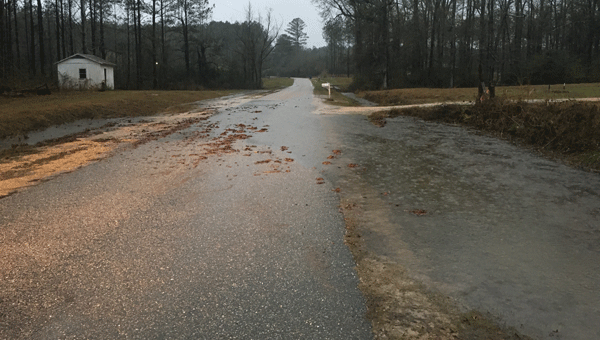Officials report 7-10 inches of rain, flooding closes roadways
Published 5:39 pm Tuesday, January 3, 2017

Butler County areas such as this road in the Sandcut community received as many as 10 inches of rain over a two-day period, courtesy of a slate of thunderstorms that swept Central and Southeast Alabama Sunday and Monday.
Given the months-long drought that baked the Alabama region at the close of 2016, “rain, rain, go away” hasn’t been a common refrain in the Butler County area for a while.
That all changed at the turn of the new year, with Butler County receiving anywhere from a reported 7 inches to 10 inches of rainfall as a slate of severe thunderstorms swept the state Sunday and Monday.
Despite multiple reports of tornado touchdowns across Central and Southeast Alabama Monday—including one in the neighboring city of Luverne—Butler County was spared of severe weather.
Shirley Sandy, director of the Butler County Emergency Management Agency (EMA), said that it was yet another case of Butler County dodging a rather large bullet.
“I think Butler County has been pretty fortunate in that, but I think the time will come,” Sandy said.
Sandy added that she hadn’t yet received any reports of structural damage, though water on roadways have led to several closed roads.
Garland Road/County Road 8, Ashley Road/Highway 24, Cooks Bridge and Mill Street were all deemed impassable due to water over the roads.
County Road 59, specifically the area south of 106, is also impassable.
Whittle Bridge is closed indefinitely due to required rehabilitation, and Bowden Bridge will require the replacement of several components, causing the reduction of its posted weight limit to 15 tons.
The bridge on Tulip Road will be closed for an estimated six months, and will require a total replacement of the structure. Duck Creek Bridge had its posted weight limit reduced to 6 tons.
Butler County engineer Dennis McCall said that the recent rainfall wasn’t the cause for bridge closings, however.
“We may have additional damage. We don’t know until we’re able to do a thorough inspection,” McCall said. “But the two bridges that were closed were actually closed a week prior during Christmas. It was all structural-related, and it wasn’t flood-related.”
Despite the notable rainfall, McCall said that the county got off relatively light compared to neighboring counties.
“We didn’t have anything as far as catastrophic failures go, but most of our closures were due to flooding,” McCall added.
“We got a lot of what I would call minor damage and a lot of maintenance-type work to do, but as far as having any road failures, we haven’t found any yet. We still have a lot of inspection to do on the crossbeam structures and the bridges as the water recedes. Unless we find something during that—which we will find a few problems, I’m sure—we’ve had nothing major.”
A pair of circumstances prevented the flooding situation from being much worse.
“We had a couple of things going for us,” McCall said. “Even the 10-inch measurements we got in some areas were spread out over a long two days. We really didn’t have any heavy flash flood events.
“The second thing is that we’re still recovering from the drought, so we had a lot of capacity in the woods and in the ponds and things like that. Had everything been saturated, we probably would’ve been looking at something comparable to what we saw in December 2015, in which we had some pretty significant damage. When all of your streams are low and all of your stagnant water areas are dry. That helped us a lot.”





